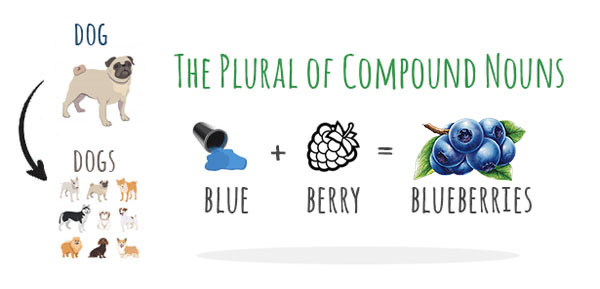What are Plural Nouns?
Another category of nouns are plural nouns. In the English language, most plural nouns are formed by adding -s or -es to the singular form. However, there are many exceptions, as we will see below.
Using -s or -es to Form the Plural Noun:
Here are some examples where the suffix -s or -es can be used to form the plural of a noun.
Example:
- dog ➡️ dogs
- car ➡️ cars
- plate ➡️ plates
- house ➡️ houses
- box ➡️ boxes
- glass ➡️ glasses
Notably, we must use the plural verb in these cases, as well.
- Those two dogs are both cute.
- Those houses are very expensive to buy.
Forming the Plural of Compound Nouns:
A compound noun is made up of more than one word. Before understanding how to form the plural, it is important to first see the variety of ways that compound nouns can be created in the English language.
| Structure | Example |
|---|---|
| noun + noun | bus stop |
| noun + adjective | mouthful |
| adjective + noun | blueberry |
| verb (ing) + noun | swimming pool |
| noun + verb (ing) | haircut |
| verb + preposition | check-out |
| noun + preposition | passer-by |
| preposition + noun | underwater |
| noun + preposition + noun | mother-in-law |
You may notice that compound nouns can be spelled with one word only (mouthful), while others use two words (swimming pool) or employ hyphens (e.g. passer-by).
Forming the plural of compound nouns is generally done by adding an ’s’ (or -es) to the principal word. Thus, you must first locate the most significant word in the compound noun (this principal word is also called the head noun). This head noun, or most significant word, gives us information about what the compound refers to.
Here are some examples of how plural compound nouns can be created once you identify the head:
| Compound noun | head | plural |
|---|---|---|
| sister-in-law | sister | sisters-in-law |
| blackberry | berry | blackberries |
| bus driver | driver | bus drivers |
| haircut | cut | haircuts |
| swimming pool | pool | swimming pools |
There is a different situation when the compound nouns end with ’-ful’ (e.g. mouthful, truckful, or handful). In this case, the noun may have two possible plurals and the -s can be added to either the head noun or to -ful, as long as one is consistent in use.
Examples:
- Add plural form to the head noun:
- mouthful, truckful, spoonsful, handful, cupsful
- Add plural form to ’-ful’:
- mouthfuls, truckful, spoonfuls, handfuls, cupfuls
In the case of a compound made up of a noun and a preposition, (such as passer-by), the nouns are the part that received the ‘s’ in order to make it plural.
Examples:
- passer-by — passers-by
Finally, there are some cases where none of the elements is a noun, as in “grown-ups” or “check-outs.” In these cases, the plural is formed by adding ’s’ to the last word. For example, the compound noun “check-outs” is made up of the noun “check” and the preposition ’out’. The plural of “check-outs” is formed by adding ’s’ to ’out’.
Examples:
- grown-up — grown-ups
- check-in — check-out
In conclusion, plural nouns represent another vital category within the realm of grammar. In English, the formation of plural nouns commonly involves the addition of suffixes such as -s or -es to their singular counterparts. Nonetheless, the intricacies of pluralization extend beyond this simple rule, encompassing numerous exceptions and irregularities. Understanding plural nouns is fundamental for mastering the nuances of the English language, providing a deeper insight into its structure and usage.


This was super helpful for my class.I’m glad I came across this.